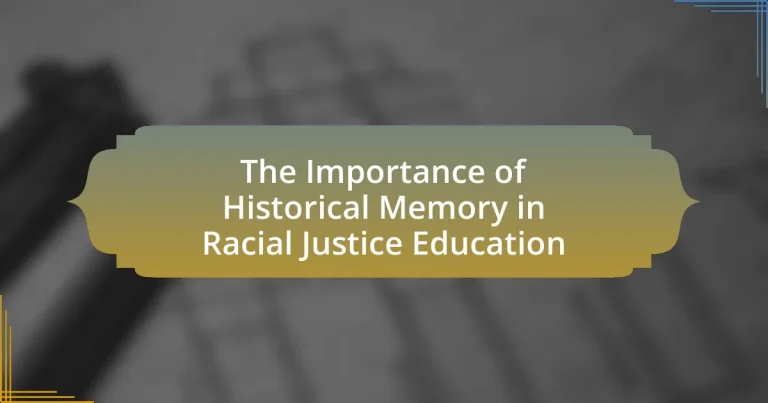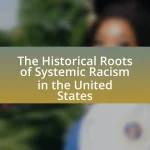The article focuses on the significance of historical memory in racial justice education, emphasizing its role in understanding systemic racism and its historical roots. It discusses how examining pivotal events such as slavery, segregation, and civil rights movements helps students recognize the ongoing impacts of these injustices on contemporary society. The article also highlights the importance of integrating diverse historical narratives into educational curricula to foster critical thinking, empathy, and social responsibility among students, while addressing the challenges educators face in teaching historical memory. Additionally, it explores the empowerment of marginalized communities through historical awareness and the implications of omitting certain narratives from education.
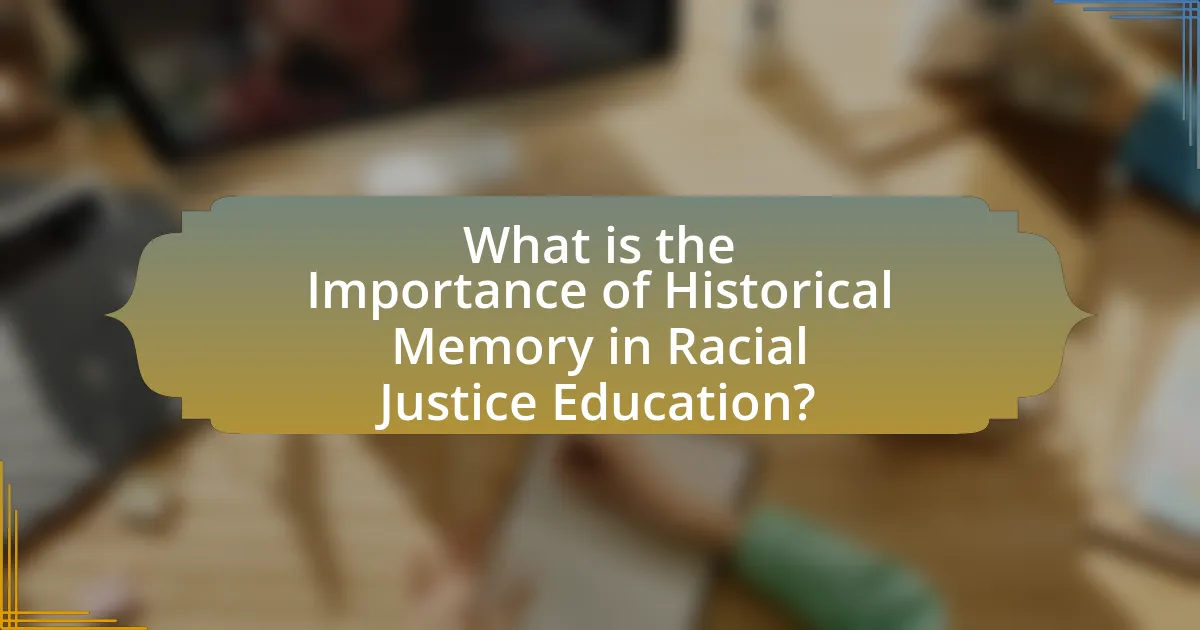
What is the Importance of Historical Memory in Racial Justice Education?
Historical memory is crucial in racial justice education as it provides context for understanding systemic racism and its historical roots. By examining events such as slavery, segregation, and civil rights movements, students can grasp the long-lasting impacts of these injustices on contemporary society. For instance, the legacy of Jim Crow laws continues to influence racial disparities in education and criminal justice today. This understanding fosters critical thinking and empathy, enabling individuals to recognize and challenge ongoing inequalities. Furthermore, historical memory serves as a tool for collective healing and empowerment, encouraging marginalized communities to reclaim their narratives and advocate for justice.
Why is historical memory crucial for understanding racial justice?
Historical memory is crucial for understanding racial justice because it provides context for current racial inequalities and injustices. By examining historical events such as slavery, segregation, and civil rights movements, individuals can recognize the systemic roots of racism that persist today. For instance, the legacy of Jim Crow laws in the United States illustrates how institutionalized racism has shaped social and economic disparities for African Americans. Understanding these historical contexts enables a more informed dialogue about contemporary issues, fostering empathy and motivating action towards equity and justice.
What role does historical memory play in shaping societal attitudes towards race?
Historical memory significantly influences societal attitudes towards race by shaping collective understanding and perceptions of racial histories and injustices. This collective memory informs how communities interpret current racial dynamics and injustices, often perpetuating stereotypes or fostering empathy based on historical narratives. For instance, the legacy of slavery and segregation in the United States continues to affect contemporary racial relations, as evidenced by ongoing disparities in wealth, education, and criminal justice outcomes. Research indicates that educational programs focusing on historical memory, such as those addressing the civil rights movement, can enhance awareness and promote racial equity by encouraging critical reflection on past injustices and their present-day implications.
How does historical memory influence the narratives taught in education?
Historical memory significantly influences the narratives taught in education by shaping the understanding of past events and their implications for contemporary society. Educational narratives often reflect collective memories that highlight specific historical events, such as civil rights movements or colonial histories, which can either promote awareness of racial injustices or perpetuate biases. For instance, the inclusion of diverse perspectives in curricula, such as the acknowledgment of systemic racism in the United States, is rooted in historical memory that seeks to educate students about the struggles for racial justice. This approach is supported by research indicating that students who learn about historical injustices are more likely to engage in discussions about equity and social justice, thereby fostering a more informed and empathetic citizenry.
How does historical memory contribute to racial justice movements?
Historical memory significantly contributes to racial justice movements by providing a framework for understanding past injustices and their ongoing impact. This collective memory informs activists and communities about historical events such as slavery, segregation, and systemic racism, which are essential for contextualizing current struggles for equality. For instance, the commemoration of events like the Civil Rights Movement serves as a reminder of the sacrifices made and the progress achieved, motivating contemporary movements like Black Lives Matter. Furthermore, studies show that education about historical injustices fosters empathy and awareness, which are crucial for mobilizing support and driving social change.
What historical events are pivotal in the context of racial justice?
Key historical events pivotal in the context of racial justice include the Emancipation Proclamation of 1863, which abolished slavery in the United States, and the Civil Rights Movement of the 1950s and 1960s, which sought to end racial segregation and discrimination. The Emancipation Proclamation, issued by President Abraham Lincoln, marked a significant turning point in American history by legally freeing enslaved individuals in Confederate states. The Civil Rights Movement, highlighted by events such as the March on Washington in 1963 and the passage of the Civil Rights Act of 1964, aimed to secure equal rights for African Americans and dismantle systemic racism. These events are foundational in understanding the ongoing struggle for racial justice and equality in the United States.
How can historical memory empower marginalized communities?
Historical memory can empower marginalized communities by fostering a sense of identity and belonging, enabling them to reclaim their narratives and advocate for social justice. This empowerment occurs as communities draw on their historical experiences of oppression and resilience to mobilize for change. For instance, the acknowledgment of historical injustices, such as slavery and segregation in the United States, has led to movements like Black Lives Matter, which seeks to address systemic racism and promote equity. Research indicates that communities that engage with their historical memory are more likely to participate in civic activities and challenge discriminatory practices, thereby enhancing their social and political agency.
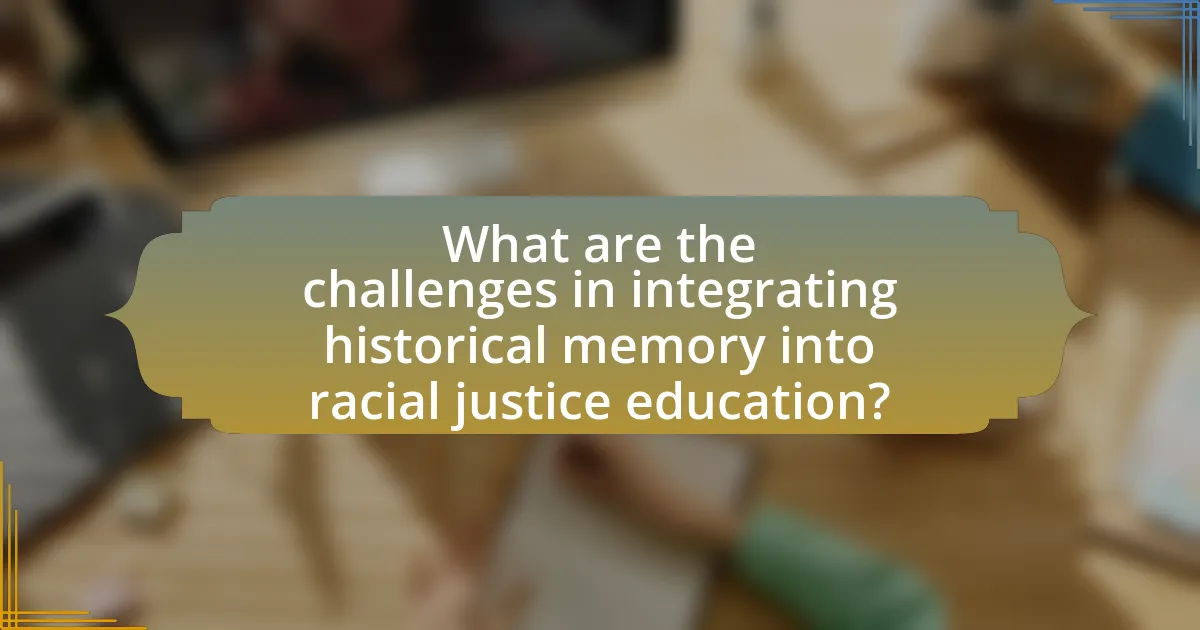
What are the challenges in integrating historical memory into racial justice education?
Integrating historical memory into racial justice education faces several challenges, primarily including the resistance to acknowledging uncomfortable truths, the oversimplification of complex histories, and the lack of diverse perspectives in educational materials. Resistance often stems from societal discomfort with acknowledging systemic injustices, such as slavery and colonialism, which can lead to pushback against curricula that address these topics. Oversimplification occurs when historical narratives are presented in a way that fails to capture the nuances of racial experiences, thereby undermining the educational goals of fostering critical thinking and empathy. Additionally, the lack of diverse perspectives in textbooks and teaching resources can result in a one-dimensional view of history, which does not adequately represent the experiences of marginalized communities. These challenges hinder the effectiveness of racial justice education by limiting students’ understanding of the historical context necessary for addressing contemporary racial issues.
What obstacles do educators face when teaching historical memory?
Educators face several obstacles when teaching historical memory, including political resistance, lack of resources, and differing interpretations of history. Political resistance often arises from stakeholders who may oppose certain narratives, particularly those related to racial justice, leading to censorship or curriculum restrictions. Additionally, a lack of resources, such as access to diverse historical texts and training for teachers, hampers effective instruction. Differing interpretations of historical events can create confusion among students and educators, complicating the teaching process. For instance, debates surrounding the portrayal of events like the Civil Rights Movement can lead to polarized views, making it challenging to present a unified historical narrative.
How do differing perspectives on history affect educational content?
Differing perspectives on history significantly affect educational content by shaping the narratives and interpretations presented in curricula. For instance, the portrayal of events such as colonization or civil rights movements can vary widely depending on cultural, political, and social contexts. This variation influences which historical figures are celebrated or vilified, which events are emphasized or downplayed, and how students understand their own identities and societal roles. Research indicates that inclusive historical narratives, which consider multiple viewpoints, foster critical thinking and empathy among students, thereby enhancing their understanding of racial justice issues. For example, the inclusion of diverse perspectives in teaching about the Civil Rights Movement can lead to a more nuanced comprehension of systemic racism and its ongoing impact, as highlighted in studies by the Southern Poverty Law Center.
What are the implications of omitting certain historical narratives?
Omitting certain historical narratives can lead to a distorted understanding of history, which in turn perpetuates systemic inequalities and hinders racial justice. When significant events or perspectives, particularly those of marginalized groups, are excluded from educational curricula, it creates an incomplete narrative that can reinforce stereotypes and biases. For example, the omission of the history of slavery and its lasting impacts in the United States can result in a lack of awareness about ongoing racial disparities. Research by the Southern Poverty Law Center highlights that inclusive historical education fosters empathy and understanding, which are crucial for promoting social justice. Thus, the implications of such omissions are profound, affecting societal perceptions and hindering progress toward equity.
How can educators effectively incorporate historical memory into their curricula?
Educators can effectively incorporate historical memory into their curricula by integrating diverse historical narratives that reflect the experiences of marginalized communities. This approach allows students to understand the complexities of racial justice and the impact of historical events on contemporary society. For instance, including primary sources such as letters, photographs, and testimonies from individuals affected by racial injustices provides students with a personal connection to history. Research by the Southern Poverty Law Center emphasizes that teaching about the civil rights movement through the voices of activists fosters critical thinking and empathy among students. By utilizing project-based learning, educators can encourage students to explore local history and its relevance to current racial issues, thereby reinforcing the importance of historical memory in shaping a just society.
What teaching strategies promote engagement with historical memory?
Interactive teaching strategies, such as project-based learning and role-playing, effectively promote engagement with historical memory. These methods encourage students to actively participate in the learning process by immersing them in historical contexts, allowing them to explore different perspectives and understand the complexities of historical events. For instance, project-based learning enables students to research and present on significant historical events related to racial justice, fostering a deeper connection to the material. Role-playing activities can help students empathize with individuals from the past, enhancing their understanding of historical narratives. Research indicates that active engagement in learning leads to better retention of information and a more profound appreciation of historical memory, as demonstrated in studies on experiential learning in history education.
How can technology enhance the teaching of historical memory in racial justice education?
Technology can enhance the teaching of historical memory in racial justice education by providing interactive and immersive learning experiences. Digital tools such as virtual reality (VR) can transport students to significant historical events, allowing them to engage with the past in a visceral way. For example, VR experiences that recreate civil rights marches enable learners to understand the emotional weight and societal impact of these events, fostering empathy and deeper comprehension.
Additionally, online platforms and multimedia resources facilitate access to diverse narratives and primary sources, which are crucial for understanding the complexities of racial justice history. For instance, the use of digital archives allows students to explore documents, photographs, and testimonies from various perspectives, enriching their understanding of historical contexts. Research indicates that students who engage with multimedia content retain information better and develop critical thinking skills more effectively than those who rely solely on traditional textbooks.
Furthermore, technology enables collaborative learning through discussion forums and social media, where students can share insights and engage in dialogue about historical memory and its relevance to contemporary issues. This collaborative approach not only enhances critical engagement but also helps students connect historical events to current racial justice movements, reinforcing the importance of historical memory in shaping future actions.
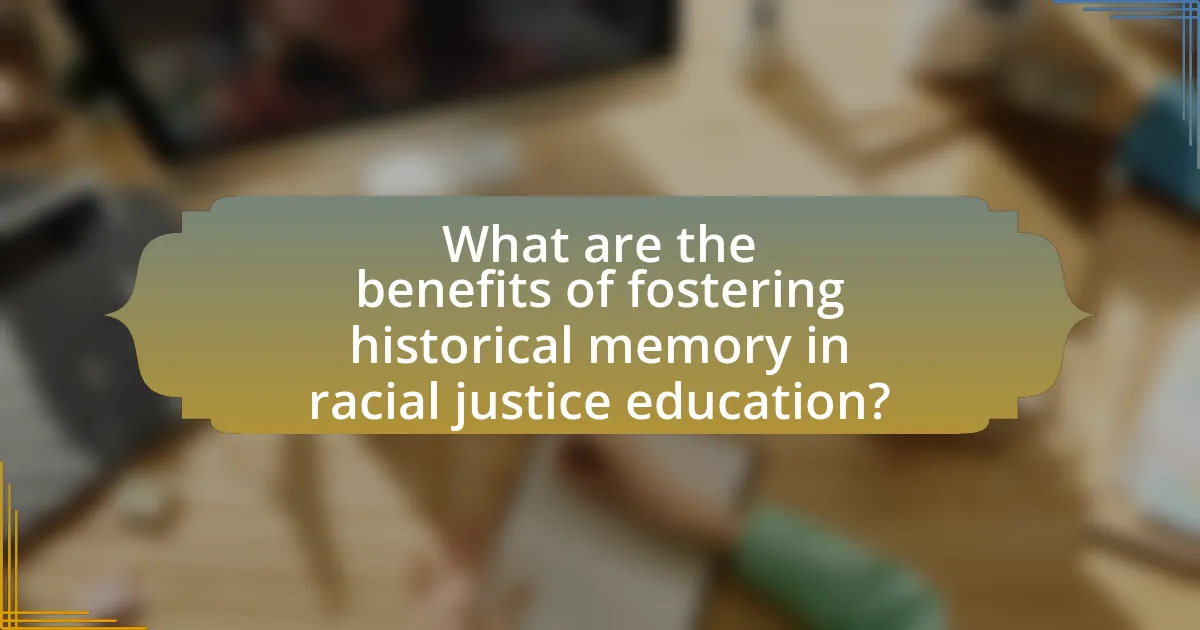
What are the benefits of fostering historical memory in racial justice education?
Fostering historical memory in racial justice education enhances understanding of systemic inequalities and promotes empathy among learners. By integrating historical events, such as the Civil Rights Movement and the impact of slavery, students gain insight into the long-standing effects of racism and discrimination. This knowledge encourages critical thinking about contemporary social issues and empowers individuals to advocate for justice. Research indicates that educational programs emphasizing historical context can lead to increased civic engagement and a commitment to social change, as evidenced by studies showing that students who learn about historical injustices are more likely to participate in activism and community service.
How does historical memory enhance critical thinking skills in students?
Historical memory enhances critical thinking skills in students by providing them with a framework to analyze past events and their implications on current societal issues. This analytical process encourages students to evaluate multiple perspectives, recognize biases, and understand the complexity of historical narratives. For instance, studies show that engaging with historical events related to racial justice, such as the Civil Rights Movement, allows students to draw connections between past injustices and present-day inequalities, fostering a deeper understanding of systemic issues. This critical engagement not only sharpens their analytical abilities but also equips them with the skills to question dominant narratives and advocate for social change.
What impact does historical memory have on students’ understanding of current racial issues?
Historical memory significantly shapes students’ understanding of current racial issues by providing context and continuity to contemporary discussions. When students learn about historical events such as slavery, segregation, and civil rights movements, they gain insights into the systemic nature of racism and its lasting effects on society. Research indicates that students who engage with historical narratives are more likely to recognize patterns of inequality and injustice in today’s world. For instance, a study by the Southern Poverty Law Center found that students who studied the history of racial discrimination were better equipped to analyze current events related to race, demonstrating a direct correlation between historical awareness and critical thinking about racial issues.
How can historical memory foster empathy and social responsibility among students?
Historical memory can foster empathy and social responsibility among students by providing them with a deeper understanding of past injustices and their impacts on marginalized communities. When students learn about historical events such as the Civil Rights Movement or the Holocaust, they can connect emotionally with the experiences of those who suffered, which cultivates empathy. Research indicates that educational programs focusing on historical memory, like the Facing History and Ourselves curriculum, enhance students’ ability to empathize with others by encouraging them to reflect on the moral implications of historical events. This reflection promotes a sense of social responsibility, motivating students to engage in actions that support justice and equality in their communities.
What role do community and family histories play in racial justice education?
Community and family histories play a crucial role in racial justice education by providing context and personal narratives that illuminate the systemic injustices faced by marginalized groups. These histories foster a deeper understanding of the socio-political dynamics that contribute to racial inequality, as they highlight lived experiences and collective memories that shape community identities. For instance, studies show that incorporating local histories into educational curricula can enhance students’ engagement and empathy, as evidenced by programs that utilize oral histories from community elders to teach about civil rights movements. This approach not only validates the experiences of marginalized communities but also empowers students to connect historical injustices to contemporary issues, reinforcing the importance of advocacy and social change.
How can personal narratives enrich the understanding of historical memory?
Personal narratives can enrich the understanding of historical memory by providing individual perspectives that highlight the emotional and subjective experiences of historical events. These narratives often reveal the complexities of history that are not captured in traditional accounts, allowing for a deeper connection to the past. For instance, testimonies from marginalized communities during events like the Civil Rights Movement illustrate the personal struggles and resilience that statistics alone cannot convey. This personal context fosters empathy and a more nuanced understanding of historical injustices, thereby enhancing the educational framework surrounding racial justice.
What are effective ways to involve families in the educational process regarding historical memory?
Effective ways to involve families in the educational process regarding historical memory include organizing community workshops, creating family engagement programs, and facilitating intergenerational storytelling sessions. Community workshops allow families to collaboratively explore historical events and their implications, fostering a shared understanding of historical memory. Family engagement programs can provide resources and activities that encourage families to discuss historical topics at home, reinforcing the educational content. Intergenerational storytelling sessions enable families to share personal narratives related to historical events, creating a deeper emotional connection to the material. Research indicates that family involvement in education enhances student learning outcomes and promotes a more comprehensive understanding of historical contexts, which is crucial for racial justice education.
What practical steps can educators take to promote historical memory in their classrooms?
Educators can promote historical memory in their classrooms by integrating diverse historical narratives into the curriculum. This approach ensures that students learn about various perspectives, particularly those of marginalized communities, which is essential for understanding racial justice. For instance, incorporating primary sources such as letters, photographs, and oral histories from different racial and ethnic groups can provide students with a more nuanced understanding of historical events. Research indicates that when students engage with multiple viewpoints, they develop critical thinking skills and a deeper appreciation for the complexities of history, which is vital for fostering a sense of justice and equity in society.
